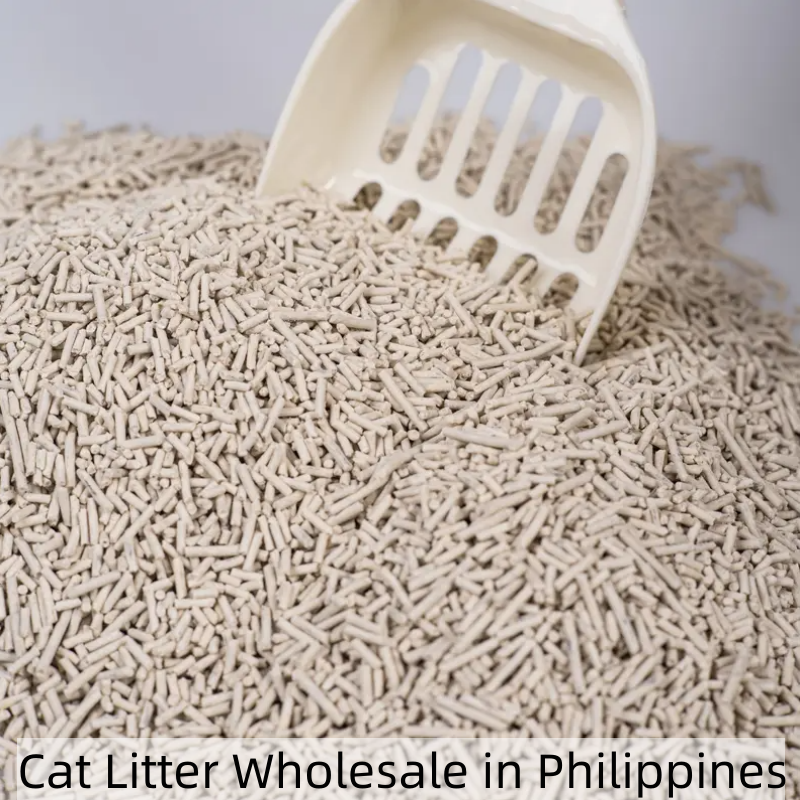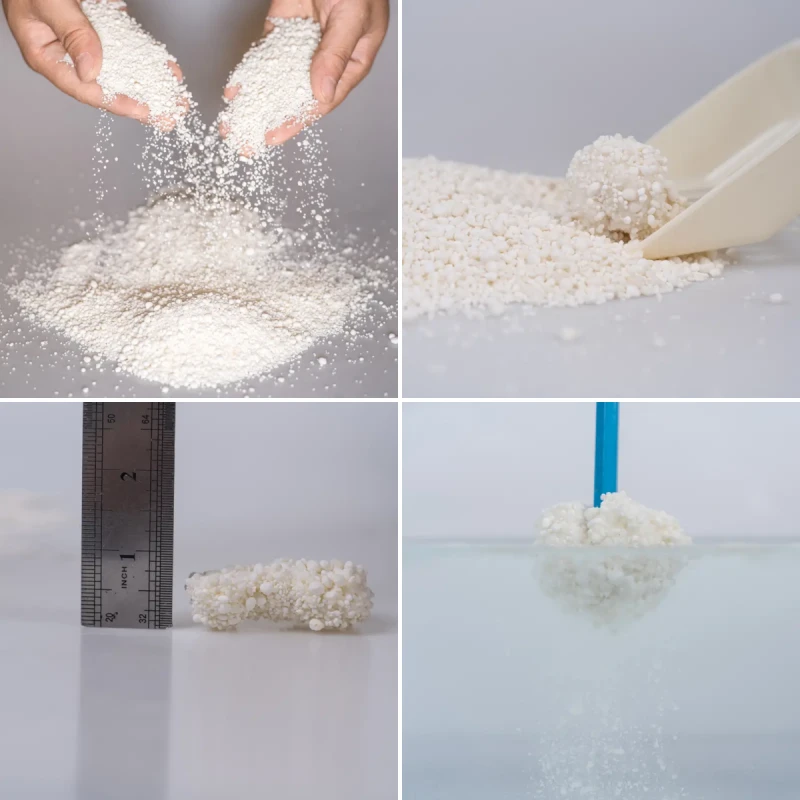Advantages of Tofu Cat Litter

(1) Environmental Friendliness
Biodegradable Benefits and Positive Environmental Impact
Tofu cat litter is made primarily from natural plant materials, which makes it highly biodegradable. In natural environments, tofu cat litter can be decomposed by microorganisms, thus avoiding pollution. In contrast, traditional cat litters like bentonite clay are non-biodegradable and can pose long-term risks to soil and water sources.
Comparison with Traditional Cat Litter in Terms of Environmental Impact
Compared to traditional cat litters such as bentonite clay and crystal cat litter, tofu cat litter has clear environmental advantages. Bentonite clay litter generates dust, is non-biodegradable, and can pollute the environment. Crystal cat litter, while highly absorbent, is also non-biodegradable and contains certain chemicals that can impact both the environment and the health of cats. Tofu cat litter, on the other hand, is eco-friendly, safe, and biodegradable, making it a more sustainable choice.
(2) Safety
Natural Ingredients Ensure Cat Health
The primary components of tofu cat litter are natural plant materials like tofu residue and tofu fibers, which do not contain any chemicals. This ensures it poses no health risks to cats. Even if a cat accidentally ingests some tofu cat litter, it is unlikely to cause serious harm.
Safety Analysis in Case of Accidental Ingestion
If a cat accidentally ingests a small amount of tofu cat litter, it typically does not pose a severe health risk. Since tofu cat litter is made from natural plant materials, it is relatively easy to digest and expel. However, if a cat ingests a large quantity, it may experience indigestion, vomiting, or diarrhea. In such cases, cat owners should promptly consult a veterinarian for appropriate treatment.
(3) Absorbency and Clumping Ability
High Absorbency Performance
Tofu cat litter has strong absorbent properties, quickly absorbing cat urine and keeping the litter box dry. This is due to the rich porosity of the natural plant materials, such as tofu residue and fibers, which rapidly absorb moisture.
Clumping Strength and Ease of Cleaning
After absorbing urine, tofu cat litter forms solid clumps that are not easily broken apart. This makes cleaning the litter box more convenient, as the clumps can be easily scooped out. Additionally, tofu cat litter clumps well without creating excessive crumbs during cleaning, reducing the difficulty of maintaining the litter box.
(4) Odor Control
Odor Control Principles and Mechanisms
The odor control effectiveness of tofu cat litter mainly comes from its natural plant ingredients and added deodorizing agents. Natural materials like tofu residue and fibers have inherent absorbent qualities, which help neutralize the odors from cat urine and feces. Furthermore, tofu cat litter often includes additional deodorizing agents like activated charcoal and diatomaceous earth, which further eliminate odors and keep the air around the litter box fresh.
Odor Control in Practical Use
In actual use, tofu cat litter demonstrates excellent odor control. It effectively removes the odors from cat urine and feces, maintaining a fresh-smelling environment around the litter box. Even in multi-cat households, it can effectively control odors, providing a comfortable living environment for both cats and their owners.
(5) Convenience of Use
Lightweight for Easy Handling and Replacement
Tofu cat litter is relatively lightweight, weighing about half as much as traditional bentonite clay litter. This makes it easier for cat owners to transport and replace the litter, especially in households located on higher floors or without an elevator.
Convenience of Flushing Directly Down the Toilet
One of the significant conveniences of tofu cat litter is that it can be flushed directly down the toilet. When the litter in the box needs replacing, cat owners can simply scoop out the clumped litter and flush it down the toilet. This method is not only convenient and quick but also reduces waste, making it more environmentally friendly.
How to Use Tofu Cat Litter and Precautions
Recommended Litter Depth
When using tofu cat litter, owners should pay attention to the depth of the litter layer. Generally, the recommended depth for tofu cat litter is about 5-8 centimeters (2-3 inches). This ensures that there is enough litter to cover the cat’s waste, which helps reduce odors. Additionally, this depth prevents the cat’s paws from directly touching the bottom of the litter box, reducing the growth of bacteria.
Frequency of Replacement
The frequency of replacing tofu cat litter depends on the number of cats and their waste output. Typically, for a single cat, the litter should be changed once a day. In multi-cat households, the replacement frequency should be adjusted based on the actual situation. Cat owners should also monitor the condition of the litter; if it becomes wet, starts to smell, or the clumps are not firm, it’s time to replace the litter promptly.
Storage Conditions and Moisture Prevention Measures
Tofu cat litter should be stored in a dry, well-ventilated area, away from direct sunlight and humidity. If the litter becomes damp, its performance and lifespan can be negatively affected. To keep the litter dry, owners can store it in a sealed container or place it in a dry cabinet.
OEM Process for Tofu Cat Litter
Requirement Communication: Clearly define the specific requirements of the product, including the specifications, performance, quality standards, packaging design, order quantity, delivery time, and other details.
Contract Signing: Once both parties agree on the OEM details, a detailed contract is signed. The contract should specify the rights and obligations of both parties, product quality standards, pricing, delivery schedule, liability for breach of contract, and other important terms.
Design and Development (if needed): If you require the OEM manufacturer to handle product design or develop a new formula, the manufacturer will carry out the necessary work based on your requirements and provide samples for your confirmation.
Production and Processing: The manufacturer will proceed with production and processing according to the agreed manufacturing processes and quality standards, ensuring strict quality control and inspection throughout the production process.
Packaging and Quality Inspection: After production, the tofu cat litter is packaged and undergoes final quality inspection to ensure the product meets the required standards.
Delivery and Logistics: The OEM manufacturer will deliver the product to you according to the agreed time and method stated in the contract. You will need to arrange for receipt and logistics as needed.
Considerations When Collaborating with an OEM Manufacturer for Tofu Cat Litter
Qualification Assessment:
Ensure the OEM manufacturer has complete production qualifications, such as a business license and health permit, which are basic guarantees for legal production.
Check if the manufacturer has relevant quality certifications, such as ISO9001 or ISO22000, which can reflect their level of production management and quality control.
Production Capacity Evaluation:
Inquire about the manufacturer's production capacity limits and current production saturation to avoid delays in your order due to the manufacturer being overloaded.
Product Quality Control:
Understand the manufacturer's quality control system, including their standards for raw material procurement, production process inspection, and finished product testing. Request quality inspection reports or samples for evaluation of key performance indicators such as absorbency, clumping ability, and odor control.
Clearly define the quality standards and acceptance criteria in the contract, and specify how quality issues will be handled and responsibilities assigned.
Research and Development Capabilities:
A manufacturer with strong R&D capabilities can continuously introduce new products or improve existing ones based on market demands and customer requirements, helping to maintain market competitiveness.
Price and Cost Negotiation:
Compare OEM prices from different manufacturers, but don’t focus solely on the lowest price. Consider factors like product quality and delivery time to ensure the best cost-performance ratio. Also, understand if the manufacturer can provide reasonable cost control solutions to help reduce overall product costs, such as advantages in raw material procurement or process optimization.
Clarify the price composition, including raw material costs, processing fees, and packaging costs, to avoid unexpected charges.
Packaging and Design Support:
If you have specific packaging requirements or design concepts, communicate with the manufacturer about their packaging design and production capabilities. Check if they offer various packaging forms and specifications and can meet personalized packaging design needs.
Confirm the quality and environmental friendliness of packaging materials to ensure they meet relevant standards and regulations.
Logistics and Delivery Arrangements:
Understand the manufacturer's shipping process and logistics methods, as well as their partnerships with logistics companies. Choose a manufacturer with high logistics efficiency and good service quality to ensure timely and safe delivery of products.
Define delivery times, locations, and methods in the contract, and specify breach of contract responsibilities to protect your interests and avoid losses due to delivery delays.
Intellectual Property Protection:
If you have your own brand or trademark, sign a confidentiality and intellectual property protection agreement with the OEM manufacturer to prevent them from disclosing your brand information or using your trademark without authorization.
Clarify intellectual property ownership issues arising during the collaboration to avoid disputes.
Clear Contract Terms:
Sign a detailed OEM contract that specifies the rights and obligations of both parties, product quality standards, pricing, delivery schedules, and breach of contract responsibilities. Ensure contract terms are specific and clear to avoid ambiguity or misunderstandings.
Pay attention to key contract elements such as confidentiality clauses, intellectual property clauses, and quality assurance clauses to ensure your legal rights are fully protected.
Communication and Service:
Maintain good communication with the OEM manufacturer before and during the collaboration, providing timely feedback on issues and needs. Evaluate the manufacturer’s communication responsiveness and problem-solving capabilities. Good communication and service can reduce friction and misunderstandings in the collaboration.
Find out if the manufacturer offers after-sales service, such as handling quality issues and response times.
Tofu cat litter stands out as an eco-friendly choice for cat owners who are mindful of their environmental impact. Its biodegradability, sustainable sourcing, low dust production, and toxin-free composition make it a responsible alternative to traditional clay-based litters. Beyond its environmental benefits, tofu cat litter also offers excellent odor control, is gentle on your cat’s paws, and is easy to clean and manage.
By choosing tofu cat litter, you’re not only providing a safe and comfortable environment for your cat but also making a positive contribution to environmental sustainability. It’s a small change that can have a big impact, proving that caring for your pet and the planet can go hand in hand.

387.webp)



122.webp)






